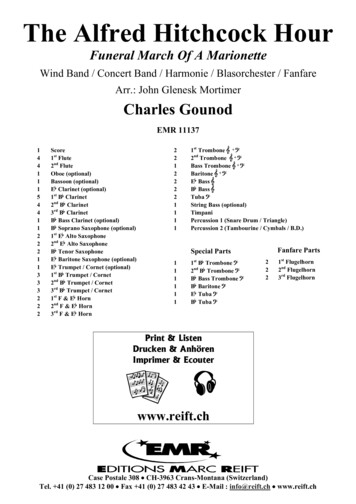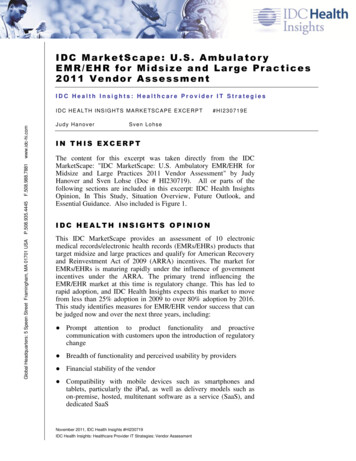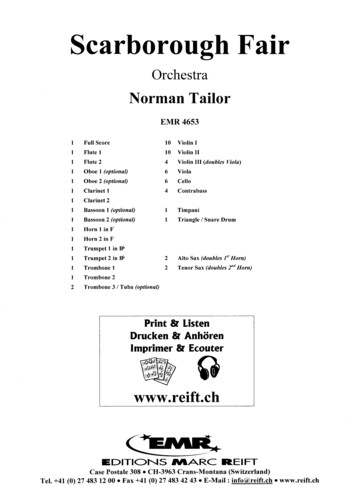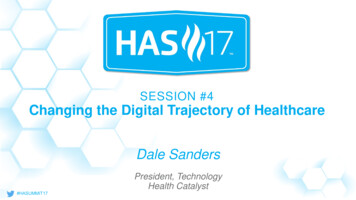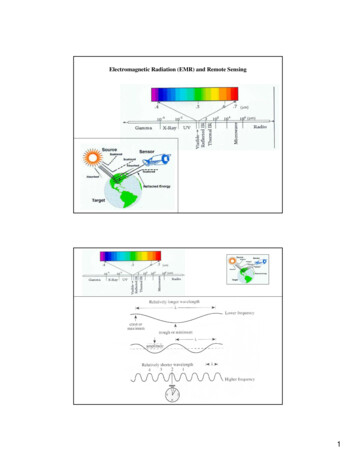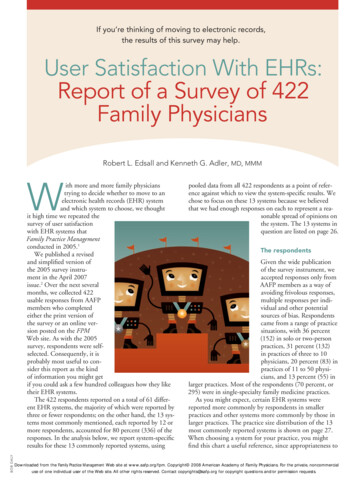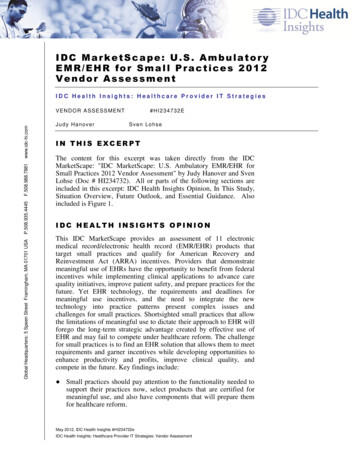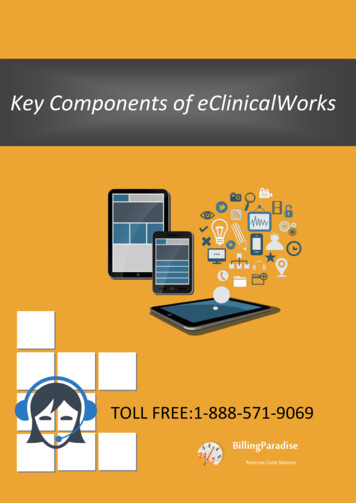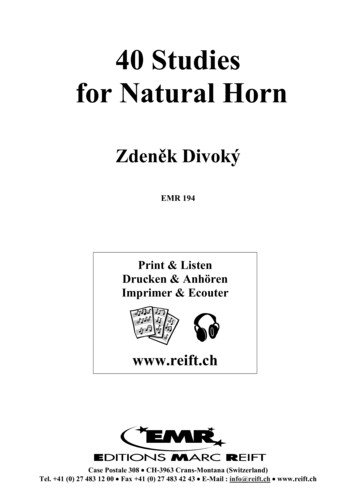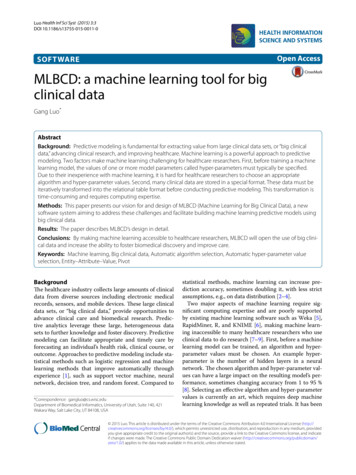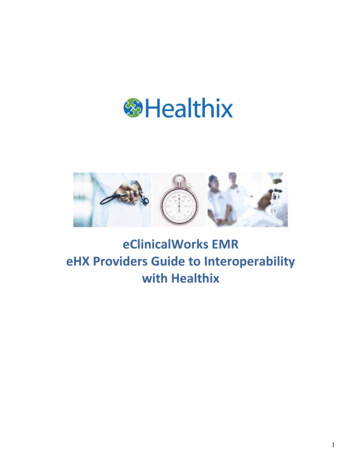
Transcription
eClinicalWorks EMReHX Providers Guide to Interoperabilitywith Healthix1
Contact Information NYC REACHo (347) 396-4940 General Healthix inquirieso (877)695-4749 Ext. 1 Healthix Help Desk Supporto (877)695-4749 Ext. 1 Healthix Email Inquirieso Info@healthix.org Healthix Help Desk Emailo Support@healthix.org www.healthix.orgo Healthix Consent Forms (CLICK HERE)o Current List of Healthix Participants (CLICK HERE)2
Table of ContentsGETTING SET UP WITH RHIO CONNECTIVITY . 4WHAT IS A RHIO . 4ABOUT HEALTHIX . 4GETTING ECLINICALWORKS CONNECTED TO HEALTHIX . 5ADDING/REMOVING PROVIDERS IN YOUR PRACTICE . 5REGISTERING PATIENTS WITH EHX . 6EXISTING PATIENTS . 6NEW PATIENTS . 7PATIENT CONSENT. 7RECORDING HEALTHIX CONSENT FOR PATIENTS . 7ABOUT EMERGENCY ACCESS . 10MINOR CONSENT . 10VIEWING CONSENT . 11EHEALTH SUMMARIES . 12REQUESTING EHEALTH SUMMARIES FROM HEALTHIX . 13VIEWING AN EHEALTH SUMMARY . 15IMPORTING A MEDICAL SUMMARY TO YOUR DOCUMENTS FOLDER. 16EXPORTING PROGRESS NOTES AND LABS TO HEALTHIX . 17LOCKING A PROGRESS NOTE . 17MANUALLY EXPORTING PROGRESS NOTES TO HEALTHIX . 18MARKING A LAB AS REVIEWED . 19MANUALLY EXPORTING LABS TO HEALTHIX. 20SECURITY SETTINGS FOR RHIO CONNECTIVITY . 21FORMSAPPENDIX A: HEALTHIX CONSENT FORM CLICK HERE APPENDIX B: HEALTHIX WITHDRAWAL OF CONSENT FORM CLICK HERE 3
Getting Set Up with RHIO ConnectivityWhat is a RHIO?A Regional Health Information Organization (RHIO) oversees and governs the exchange of health-relatedinformation among organizations according to nationally recognized standards. In order to becomeconnected to a RHIO within eCW, you must first become a member of that RHIO. There are currently threeRHIOs in the New York City area to choose from. Bronx RHIOHealthix RHIOInterboro RHIOEach RHIO collects clinical data from varying data sources. Although each RHIO complies with State andFederal policies, each has distinct policies and processes regarding how they share that data.About HealthixHealthix services Greater New York (Manhattan, Brooklyn, Queens, Staten Island and Long Island) region.Healthix supports sharing of healthcare data among practitioners, hospitals, long term and home careservices, community based organizations, government agencies, insurers and more. Healthix aggregatesdata from over ten million patients, representing encounters at dozens of health care facilities and insurers,most of whom feed data on a real time basis. To view a list of Healthix particpants, please refer tohttp://healthix.org. Healthix provides its members with ongoing user support and technical assistance;questions and comments can be directed to support@healthix.org or (877)695-4749 Ext. 14
Existing Methods of Data ExchangeSupporting coordinated care and emerging models for reimbursement has,until now, required point to point interfaces that are inflexible, costly anddifficult to maintain.How Healthix HelpsConnecting to Healthix provides access to a growing roster of clinical datasources and services and a gateway to State and national networks.Getting eClinicalWorks connected to HealthixTo access the community wide data available in Healthix, your practice must first become a participant ofHealthix.Once you have signed up with Healthix and completed all the necessary documents, eCW will helpdetermine if you require an eCW software upgrade. Once your practice has been upgraded to theappropriate version of eCW, an eCW technician will configure your practice for RHIO connectivity. Theconfiguration will occur outside your normal practice hours and once it’s complete, you will be connected toHealthix and can begin data exchange.To provision users, Healthix will provide the Healthix Provisioning worksheet. Practices should complete theworksheet by adding a list of employees at your practice that will be using eCW to access RHIO data. Afterwe authorize each individual for access to Healthix data, they will have two avenues from which to view apatient’s RHIO data- (1) through their eCW EMR or (2) through the Healthix System.In addition to viewing RHIO data within your eCW EMR, Healthix will provide you with access to a broadrange of clinical information and related functionality to enhance patient care and support emerging modelsof care coordination. These tools include real-time notifications, secure user-to-user messaging, and acustomizable Patient Summary Report. For a demonstration of the Healthix System, contact the HealthixTeam at (877)695-4749 Ext. 1 or info@healthix.org5
Adding/Removing providers in your practiceAs new providers join or leave your practice, you will need to notify Healthix and eCW. The RHIOconnectivity functions in eCW are only displayed for providers who are registered for RHIO connectivity. If aprovider does not see the functions described in this training manual when they log into the eCW EMR,contact your eCW administrator to make sure the provider’s login has been correctly configured.To ensure patient security, RHIOs only process transactions from authorized practices and practicemembers. In order to gain access to patient information from the RHIO, the practice ID and user ID must beregistered with the RHIO. Contact the Healthix Team at (877)695-4749 Ext. 1 for details on how to manageaccess as well as addressing changes made to your staff.Registering patients with eHXExisting PatientsWhen you are first set up with Healthix connectivity, all existing patients must be registered with eCW’s eHXapplication. eHX is the gateway between your eCW EMR and the RHIO. When clicking on a patient from thePatient Lookup window, if the patient has not yet been registered with eHX, a popup will be displayedasking, “The patient has to be exported or linked to eHX. Do you want to export or link this patient?” ClickYes. If you click No, you will not be allowed to move forward in eCW.Figure 1: Patient Lookup Window6
Once you click Yes, the patient will be registered with eHX. You will now see a blue dash in the eHX columnof the Patient Lookup window. The blue dash next to the patient name confirms that the patient is nowlinked to eHX but has not been yet completed a Healthix consent form.Figure 2: Patient Lookup Window with “blue dash” representing linkage to eHX environmentNew PatientsNew patients to your practice will automatically be registered, but not consented, into eHX when theirrecord is created.Patient ConsentAs per New York State law, RHIO consent is consent to access data through a RHIO, not consent to uploaddata to the RHIO. A patient’s clinical data can be uploaded to a RHIO regardless of the patient’s consent.The RHIO manages patient consent and shares a patient’s data only with those authorizedpractices/providers that have obtained and recorded Healthix consent by the patient. This does not apply toconsent for minors (i.e. anyone under 18 years of age); please review the section on Minor Consent on Page10. Patience consent obtained at your practice applies to all authorized eCW and Healthix users.The Healthix Participation/Business Associate Agreement, a HIPAA-compliant document, allows Healthix toact as a custodian of the contributing organizations’ data, and hold and aggregate it. Consequently, patientconsent is only required at the time access.Recording Healthix consent for patientsIn order for Healthix users from your organization to obtain a patient’s clinical information from Healthix,the patient must grant consent to your practice to view aggregated data. This is done by completing theHealthix consent form (Appendix A). Healthix provides all its members with templates of the New York Stateapproved Healthix consent form which should be customized for each practice. The Healthix consent formsare offered in 17 different languages; for a full listing please visit patient-consent-forms/. All RHIO consent forms comply with the New York StatePrivacy and Security laws and are subject to the privacy policies and procedures of the RHIO. Healthixconducts an annual consent audit to ensure that all member organizations and provider practices are incompliance with statewide guidance and Healthix Privacy Policies and Procedures.There are several types of Healthix consent values that a patient can choose(consent can be changed and/orrevoked at any time):1) Give: Patient gives consent to the practice to view their community-wide record from Healthix.2) Deny: Patient Denies consent to the practice to view their community-wide record from Healthix.3) Emergency Only or Undecided: Patient chooses to give consent only in an emergency situation, or if aconsent decision is not made the default remains undecided which will restrict access to Healthixdata through your eCW application.4) Deny All: Patients have the right to deny access to all providers indefinitely. To do so theseindividuals should be referred to Healthix at support@healthix.org7
Each of the above Healthix consent values has a corresponding selection within the eCW Consent Window:Table 1Healthix Consent Form ChoiceOption to select on the eCW Consent windowI GIVE consentOpt-InI DENY consentOpt-outUNDECIDEDEmergency (n/a in eClinicalWorks)** See Page 10 for a detailed description of Emergency AccessTo record consent for an individual:1. From the appointment window, click on the eHX status iconFigure 3: Appointment Window2. You can also record consent from the Patient Hub by clicking the eHX Consent buttonFigure 4: Patient Hub Window8
The eHX Patient Consent window displaysFigure 5: eHX Patient Consent Window3. Select the consent value indicated by the patient on the Healthix consent forma. If a patient has selected “Give Consent” on the consent form, they are authorizing access to theirdata from the RHIO, select Opt-In and check the Received signed consent check box.b. If a patient has selected the “Deny Consent” checkbox on the consent form, they do not want theirinformation to be made available to the practice, select Opt-Out on the eCW consent window andcheck the Received signed consent check box.c. If a patient does not complete the Healthix consent form and is authorizing the practice to accesstheir data only in an emergency, hit the Cancel button and exit the eHX consent window. If apatient opts-in only in emergencies, the practice may only use the Healthix System to access thedata in an emergency. The data is not available through eCW.4. To select the date the consent form was signed:a. Click in the Date Signed field. A pop-up calendar displays.b. Select the date the consent form was signed. The selected date is added to the Date Signed field5. Click the Scan Form button to scan a consent form as you would any other document. (The scanned formis saved to the Patient Documents folder with the name Consent Yes if they opted in or Consent No ifthey opted out). These folders are automatically created for you. It’s important to store all consentforms (either by scanning or filing) for annual audit by Healthix (per statewide guidance and HealthixPolicies). Healthix will contact your practice for an annual review for all consent forms.6. To select the facility at which this patient is being registered, click the dropdown button next to theFacility field and select the facility from which you are registering this patient.7. Click the Save button. Upon clicking the save button, the consent value is transmitted to your RHIO andstored.8. Provide a copy of the Healthixconsent form to your patient9
To change consent for an individual:A patient can change their consent status at any time.1. If a patient previously gave consent but now wishes to withdraw consent, they must fill out a HealthixWithdrawal of Consent Form. This returns the patient to an ‘Undecided’ Healthix consent value. Scan thisform, select the Emergency radio button and click SAVE. The new consent status will be registered withHealthix.2. If a patient previously gave consent or gave consent only in an emergency, but now wishes to denyconsent, they must fill out a new consent form and select the “I DENY consent” option. Scan this form,select Opt-out and click SAVE. The new consent status will be registered with your RHIO.Note: Patient consent does not expireAbout Emergency Access:In accordance with Healthix policies, a patient may choose not to make a consent decision and remain‘Undecided.’ This means the patient does not choose ‘give’ or ‘deny’, leaves the consent form blank, anddoes not provide a signature. In this case, because the patient has not explicitly denied consent, clinicianswith the proper Healthix user role are allowed to view their community wide record in the case of anemergency.If a patient at your practice chooses to remain ‘Undecided’, implicitly authorizing clinicians to view their datain the case of an emergency, their consent value in eCW will be displayed as ‘Emergency.’ However, thisdoes not mean that you will be able to view their data through eCW in a medical emergency. For thesepatients, RHIO data can only be viewed through the Healthix System.Viewing RHIO data in a medical emergency is often referred to as a “Break the Glass” event. A Break theGlass event can occur when an authorized clinician attests that the patient is facing a medical emergencyand viewing community wide data is necessary for treatment. Not all users of the Healthix System have theappropriate user permissions to “Break the Glass.” Please refer to the Healthix Policies.Minor consentUnder Healthix Policies, minors under the age of 10 can have their consent status selected by their parent orguardian. Between the ages of 10 and 18 access to Healthix data will not be permitted through eCW andconsent should not be collected from parents on behalf of these patients. All minor consents, even ifmistakenly collected, will default to ‘Undecided’ in Healthix, allowing emergency only/Break the Glass accessby authorized clinicians through the Healthix System. In this case, if minor consent is being displayed as‘grant’ or ‘deny’ in eCW, clinicians should disregard that value since it will be suppressed and access to theminor’s record will be restricted to emergency situations.10
Viewing consentTo view consentPatient consent is displayed in a number of places throughout the system. The icons in this column indicatethe consent status of the patient. The five consent icons are:Table 2IconDescriptionGrant Consent: The patient has given consent for your practice to access data. The Opt-Inradio button has been selected in the consent window.Deny Consent: The patient has denied consent for your practice to access data. The OptOut radio button has been selected in the consent window.Undecided/Emergency only: The patient has chosen to stay undecided; your practice canaccess data only in an emergency through the Healthix System.Undecided: The patient was added since the practice was set up with eHX, but has notcompleted a Healthix consent form. The Emergency radio button has been selected bydefault in eCW.[Blank]1) The patient was added before the practice was set up with eHX, and has not been tothe office since eHX was enabled at your practice. When your practice first goes livewith eHX, all of your existing patients will have this status; OR2) The patient was a minor but has since turned 18 and will need to consent as an adult.Patient consent can be found in the following areas:Patient demographics windowFigure 6: Patient Demographics Window- Patient has Granted Consent11
The Patient Lookup windowFigure 7: Patient Lookup WindowThe Appointment window when scheduling appointmentsFigure 8: Appointment Window- Patient has Granted ConsenteHealth SummariesElectronic Health Summaries (Ehs), also referred to as a patient’s community-wide record, contained inHealthix can be viewed and imported from the Progress Notes window and the Patient Hub. The eHealthSummaries are generated by Healthix and are an aggregation of clinical data received from a number ofdifferent sources such as hospitals, labs, long-term health care facilities and other providers. For an updatedlist of Healthix participants, please refer to healthix.org.12
Requesting eHealth summaries from HealthixTo request a patient’s eHS:1. You can access eHealth Summaries from two places; from the Progress Notes window and from thePatient Hub window; by clicking on the Patient External Documents link. You can also access the PatientSummary through the Healthix System.Figure 9: Progress Notes WindowFigure 10: Patient Hub Window13
2. Click on the Patient External Documents link. The Import Documents window will appearFigure 11: Import Documents Window3. Click on the Refresh External Data link to get the latest data from Healthix. You will see a message“requesting registry please wait”. To ensure you are getting the most recent data from Healthix,always refresh the data before opening any document4. If data is available, you will see a link called “Patient Detail”. This document will contain an aggregationof all clinical data available in Healthix for this patient. If data is not available or if consent has not beengranted, you will see a “No Document Found” message.Figure 12Interfaces with Healthixdo not support a daterange query. YOU MUSTINDICATE THE CURRENTDAY – It will generate adocument that presentsall available patientclinical data.5. For the PCIP implementation, only aggregated eHealth Summaries will be returned. These documentscan be found on the All and the Medical Summary tabs. You will not find documents on the Labs,Scanned Documents and PHR tabs.14
Viewing an eHealth summaryTo view a patient’s eHS:1. Click on the name of the document in the Import Documents window. The eHS will open in a newwindow.Figure 13You may see the following sections within your eHS (the order may differ from RHIO to RHIO). : PatientAuthorCustodianEncompassing EncounterTable of ContentsAdvanced DirectivesProblemsAllergies, Adverse Reactions, Alerts Family HistorySocial HistoryMedicationsImmunizationsVital SignsResultsProceduresEncountersYou will only see the sections for which there is data for your patient. The eHS follows the standardCCD (Continuity of Care Document) format.15
Figure 14The table of contents lists each clinicalsection of the eHS that is included foryour patient. Click on a link to takeyou directly to a specific section.Note: Depending on the amount of data available, you may need to use the up/down and left/rightscrollbar to view all of the data.Importing a medical summary to your documents folderTo import a patient’s eHS to your EMR:1. From the Import Documents screen, select the checkbox next to the document you would like toimport. You must have opened the document before you can save it.2. Click on the Import to EMR link in the top left cornerFigure 15: Import Documents Window3. These documents will be saved to the Patient Documents folder.16
Exporting Progress Notes and Labs to HealthixOnce a practice is configured for RHIO connectivity through eCW, all locked progress notes and reviewedlabs will be registered with the RHIO, regardless of the consent status recorded for the patient. This is incompliance with New York State law which defines RHIO consent as consent to access data, not consentto upload data to a RHIO. Access to the clinical data within these documents is restricted only toproviders to which the patient has given consent and is governed by your RHIO.Once a progress note is locked, the various parts of the eCW progress note will be transmitted toHealthix and parsed and incorporated into their respective categories in the Healthix Patient Record andwill also be available as a complete CCD in the Documents tab. However, when receiving an eHealthSummary from Healthix, the eHealth Summary will display as is and will not be parsed into the varioussections of eCW. eHealth Summaries can be imported as a document into the patient’s record.Both eHealth summaries/progress notes and labs are registered with the RHIO every night. This is anautomated process, and will occur for all locked progress notes and all reviewed labs. Providers alsohave the option to manually export both eHealth summaries and labs to the RHIO real-time. To shareyour data with other clinicians, it’s very important to lock notes and mark labs as reviewed as part ofyour practice workflow.Locking a progress note1. Click the Lock button from the progress note to lock the documentFigure 16: Progress Note Window17
2. You will be asked to confirm locking the encounter. Click Yes. The document will be registered withHealthix.Figure 17: Lock Encounter WindowManually exporting progress notes to HealthixIf there is an urgent need to register clinical data with Healthix before the automated nightly process,you have the option to manually export progress notes and labs.Manually exporting an eHS1. Click the Export eHS button from the desired patient’s Hub to upload their locked encounters toHealthix.Figure 18: Patient Hub Window18
2. You will be asked to confirm the export. Click Yes.Figure 193. You will receive another popup confirming the document was successfully exported. Click OK. Thedocument is now registered with Healthix.Figure 20Marking a lab as reviewed1. Mark the lab as “Reviewed” and click OK.Figure 21: Lab Results Window19
Manually exporting labs to HealthixManually Exporting Labs1. Click the Export Labs button from the Patient Hub.Figure 22: Patient Hub Window2. When you click on the Export Labs button, you will be asked to confirm the export. Click Yes.Figure 2320
3. You will receive another popup confirming the lab was successfully exported. Click OK.Figure 24The eHealth Summary will be updated within 2-3 minutes.Security Settings for RHIO ConnectivityThe Practice Administrator has the ability to turn on or off visibility to certain RHIO connectivity features.By going to the “By User” tab in the Security Settings in eCW, the Administrator can uncheck “IHEDocuments Access”. If unchecked, the user will no longer have visibility to the “External Documents” linkon the Patient Hub. They will still be able to record consent and any locked progress notes or reviewedlabs will still be registered with the RHIO.Note: Practices are not required to manage these configurations. eCW will be responsible for anychanges in the security settings.Figure 25: Security Settings Window21
patients RHIO data- (1) through their eCW EMR or (2) through the Healthix System. In addition to viewing RHIO data within your eCW EMR, Healthix will provide you with access to a broad range of clinical information and related functionality to enhance patient care and support emerging models of care coordination.
